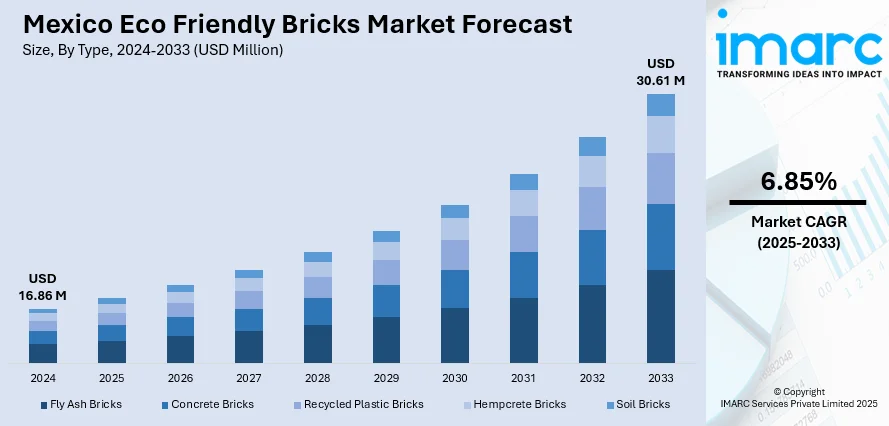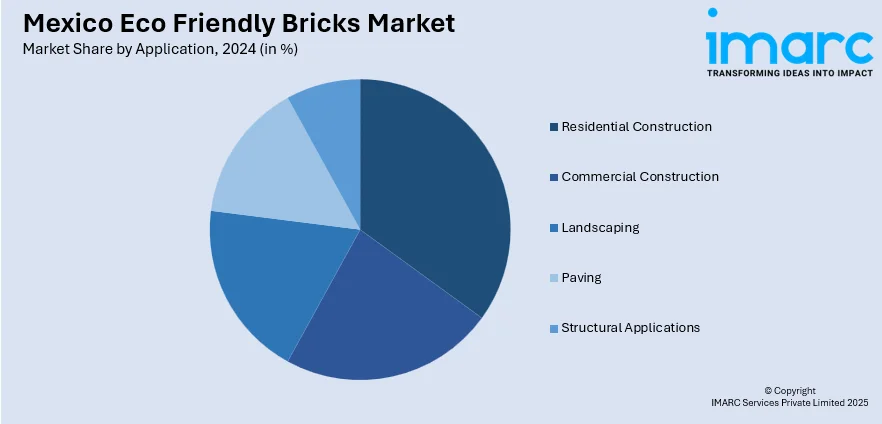
Mexico Eco Friendly Bricks Market Size, Share, Trends and Forecast by Type, Application, and Region, 2025-2033
Mexico Eco Friendly Bricks Market Overview:
The Mexico eco friendly bricks market size reached USD 16.86 Million in 2024. Looking forward, IMARC Group expects the market to reach USD 30.61 Million by 2033, exhibiting a growth rate (CAGR) of 6.85% during 2025-2033. The market is expanding due to rising environmental awareness, government incentives promoting sustainable construction, and the adoption of innovative materials like compressed earth blocks and recycled-content bricks. Urbanization and the push for energy-efficient housing further drive demand. These factors collectively contribute to the evolving landscape of the Mexico eco friendly bricks market share.
|
Report Attribute
|
Key Statistics
|
|---|---|
|
Base Year
|
2024 |
|
Forecast Years
|
2025-2033
|
|
Historical Years
|
2019-2024
|
| Market Size in 2024 | USD 16.86 Million |
| Market Forecast in 2033 | USD 30.61 Million |
| Market Growth Rate 2025-2033 | 6.85% |
Mexico Eco Friendly Bricks Market Trends:
Government Policies and Green Building Incentives
Government initiatives play a crucial role in promoting eco-friendly bricks in Mexico. Programs like the Sustainable Housing Program and Green Mortgages from INFONAVIT encourage developers to incorporate energy-efficient and environmentally responsible materials. These initiatives aim to reduce carbon emissions, lower household energy use, and promote healthier living conditions. Agencies like CONUEE actively support energy efficiency standards, offering incentives and regulatory frameworks that guide sustainable construction. Additionally, national development plans increasingly highlight climate resilience, aligning housing strategies with sustainability targets. These policy efforts stimulate demand for green materials, including bricks made from recycled or low-carbon inputs. As awareness of environmental impact grows across industries, these policies position eco-friendly bricks as a preferred choice for both residential and commercial construction, driving their adoption in Mexico’s evolving building market.

Technological Advancements and Material Innovation
Technological advancement is a key driver in Mexico eco-friendly bricks market. Innovations in material science have enabled manufacturers to incorporate recycled content such as fly ash, waste glass, and construction debris into brick production. This not only reduces reliance on traditional raw materials but also helps lower emissions and waste. Companies like Holcim Mexico are introducing circular economy practices with technologies like ECOCycle, recycling demolition waste into eco-efficient construction materials. Improved kiln technologies and automation also contribute to lower energy consumption and better-quality control. These innovations make eco-friendly bricks more competitive in terms of cost and performance. As sustainable construction becomes a national priority, technological breakthroughs continue to shape the market, offering scalable and environmentally responsible alternatives for future infrastructure and housing needs.
Rising Consumer Awareness and Sustainable Housing Demand
Growing consumer awareness of environmental issues significantly boosts the demand for eco-friendly bricks in Mexico. Urban populations, particularly younger generations, are showing a strong preference for sustainable housing options that reduce environmental impact and enhance energy efficiency. Eco-friendly bricks meet these needs with benefits such as improved thermal insulation, durability, and lower embodied carbon. As climate change becomes a central concern, buyers are making value-driven decisions, preferring homes built with green materials. Developers and architects are responding by incorporating eco-bricks into their designs to meet evolving market expectations. This shift toward eco-conscious living is transforming the construction landscape, reinforcing the importance of sustainable materials. As awareness and demand increase, consumer influence is expected to remain a powerful factor shaping Mexico eco-friendly bricks market growth.
Mexico Eco Friendly Bricks Market Segmentation:
IMARC Group provides an analysis of the key trends in each segment of the market, along with forecasts at the country and regional levels for 2025-2033. Our report has categorized the market based on type and application.
Type Insights:
- Fly Ash Bricks
- Concrete Bricks
- Recycled Plastic Bricks
- Hempcrete Bricks
- Soil Bricks
The report has provided a detailed breakup and analysis of the market based on the type. This includes fly ash bricks, concrete bricks, recycled plastic bricks, hempcrete bricks, and soil bricks.
Application Insights:

- Residential Construction
- Commercial Construction
- Landscaping
- Paving
- Structural Applications
A detailed breakup and analysis of the market based on the application have also been provided in the report. This includes residential construction, commercial construction, landscaping, paving, and structural applications.
Regional Insights:
- Northern Mexico
- Central Mexico
- Southern Mexico
- Others
The report has also provided a comprehensive analysis of all the major regional markets, which include Northern Mexico, Central Mexico, Southern Mexico, and others.
Competitive Landscape:
The market research report has also provided a comprehensive analysis of the competitive landscape. Competitive analysis such as market structure, key player positioning, top winning strategies, competitive dashboard, and company evaluation quadrant has been covered in the report. Also, detailed profiles of all major companies have been provided.
Mexico Eco Friendly Bricks Market Report Coverage:
| Report Features | Details |
|---|---|
| Base Year of the Analysis | 2024 |
| Historical Period | 2019-2024 |
| Forecast Period | 2025-2033 |
| Units | Million USD |
| Scope of the Report |
Exploration of Historical Trends and Market Outlook, Industry Catalysts and Challenges, Segment-Wise Historical and Future Market Assessment:
|
| Types Covered | Fly Ash Bricks, Concrete Bricks, Recycled Plastic Bricks, Hempcrete Bricks, Soil Bricks |
| Applications Covered | Residential Construction, Commercial Construction, Landscaping, Paving, Structural Applications |
| Regions Covered | Northern Mexico, Central Mexico, Southern Mexico, Others |
| Customization Scope | 10% Free Customization |
| Post-Sale Analyst Support | 10-12 Weeks |
| Delivery Format | PDF and Excel through Email (We can also provide the editable version of the report in PPT/Word format on special request) |
Key Questions Answered in This Report:
- How has the Mexico eco friendly bricks market performed so far and how will it perform in the coming years?
- What is the breakup of the Mexico eco friendly bricks market on the basis of type?
- What is the breakup of the Mexico eco friendly bricks market on the basis of application?
- What is the breakup of the Mexico eco friendly bricks market on the basis of region?
- What are the various stages in the value chain of the Mexico eco friendly bricks market?
- What are the key driving factors and challenges in the Mexico eco friendly bricks market?
- What is the structure of the Mexico eco friendly bricks market and who are the key players?
- What is the degree of competition in the Mexico eco friendly bricks market?
Key Benefits for Stakeholders:
- IMARC’s industry report offers a comprehensive quantitative analysis of various market segments, historical and current market trends, market forecasts, and dynamics of the Mexico eco friendly bricks market from 2019-2033.
- The research report provides the latest information on the market drivers, challenges, and opportunities in the Mexico eco friendly bricks market.
- Porter's five forces analysis assist stakeholders in assessing the impact of new entrants, competitive rivalry, supplier power, buyer power, and the threat of substitution. It helps stakeholders to analyze the level of competition within the Mexico eco friendly bricks industry and its attractiveness.
- Competitive landscape allows stakeholders to understand their competitive environment and provides an insight into the current positions of key players in the market.
Need more help?
- Speak to our experienced analysts for insights on the current market scenarios.
- Include additional segments and countries to customize the report as per your requirement.
- Gain an unparalleled competitive advantage in your domain by understanding how to utilize the report and positively impacting your operations and revenue.
- For further assistance, please connect with our analysts.
 Request Customization
Request Customization
 Speak to an Analyst
Speak to an Analyst
 Request Brochure
Request Brochure
 Inquire Before Buying
Inquire Before Buying




.webp)




.webp)












